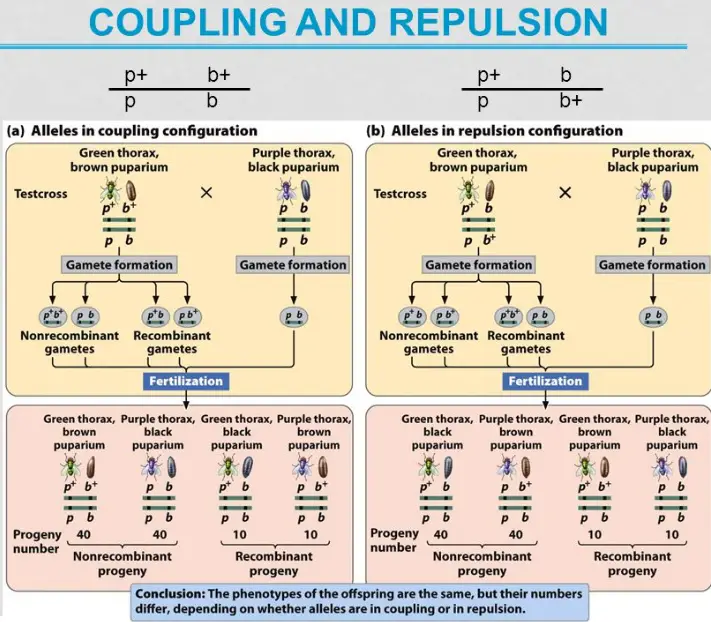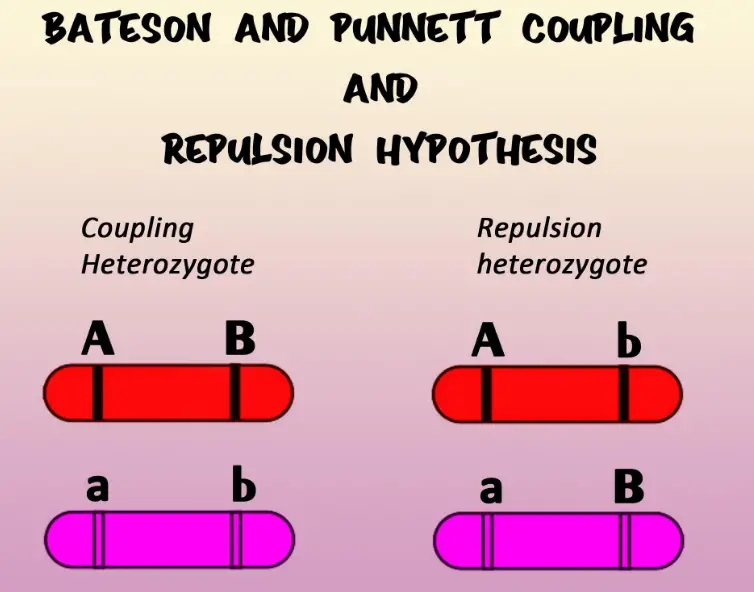Genetic linkage is a fundamental concept in the study of genetics, governing how genes on the same chromosome are inherited together. This intricate relationship between genes can manifest in two distinct forms: coupling and repulsion. These genetic phenomena are pivotal in understanding how traits are passed from parents to offspring and have significant implications in fields such as genetic research and breeding.
Coupling and repulsion refer to the orientation of alleles on a chromosome and their effects on inheritance patterns. Coupling occurs when two or more beneficial alleles are inherited together more frequently than expected by chance, whereas repulsion describes the situation where beneficial alleles are inherited less frequently. This basic distinction helps researchers predict and manipulate genetic outcomes in various organisms.
Despite their crucial roles, the concepts of coupling and repulsion are often misunderstood. Both phenomena stem from the physical proximity of genes on chromosomes, influencing genetic diversity and the outcome of breeding programs. A deeper appreciation of these mechanisms can enhance our ability to diagnose genetic disorders, improve crop yields, and even assist in the conservation of endangered species.

Genetic Basics
Explanation of Genes and Alleles
Genes are the basic physical and functional units of heredity. They are made up of DNA and act as instructions to make molecules called proteins. Every person has two copies of each gene, one inherited from each parent. These genes come in different versions, called alleles. Alleles can be dominant or recessive, with the dominant allele masking the presence of the recessive in determining a trait.
For example, if the allele for brown eyes is dominant over the allele for blue eyes, a person with one allele for brown eyes and one for blue will have brown eyes. The existence of different alleles contributes to the genetic diversity within populations, impacting everything from physical appearance to susceptibility to diseases.
Overview of Chromosome Structure
Chromosomes are thread-like structures located inside the nucleus of animal and plant cells. Each chromosome is made of protein and a single molecule of deoxyribonucleic acid (DNA). Passed from parents to offspring, DNA contains the specific instructions that make each type of living creature unique.
The structure of a chromosome is critical because it helps to ensure DNA is accurately copied and distributed in the vast majority of cell divisions. Human cells have 23 pairs of chromosomes, for a total of 46. Twenty-two of these pairs are autosomes and one pair is the sex chromosomes, which determine a person’s sex.
Linkage Concepts
Definition of Genetic Linkage
Genetic linkage occurs when genes are located close together on the same chromosome. These linked genes tend to be inherited together because they are physically connected, and the likelihood of them being separated during crossing over in meiosis is lower than if they were farther apart.
Factors Affecting Linkage
Several factors influence genetic linkage:
- Distance between genes: The closer two genes are on a chromosome, the greater the chance they will be inherited together.
- Crossing over frequency: This is a process where chromosomes exchange segments; higher crossing over rates can break the linkage.
- Chromosome arrangement: Certain chromosomes may have a higher propensity for linkage due to their structure and function.
Coupling Explained
Definition and Basics
Coupling, also known as cis configuration, occurs when two alleles that cause specific traits are inherited together from one parent. In simple terms, if an individual inherits two beneficial alleles of two genes that are close together on the same chromosome, it is said that these alleles are in coupling.
How Coupling Occurs in Genetics
Coupling typically occurs under the following circumstances:
- Proximity of genes: Genes close together on a chromosome are more likely to be inherited together.
- Parental origin: Alleles from one parent tend to stay together if the genes are close enough on the chromosome.
For instance, if a parent has a genotype AaBb, where A and B are dominant alleles and located near each other, their child is more likely to inherit these two dominant alleles together.
Repulsion Explained
Definition and Basics
Repulsion, or trans configuration, happens when one dominant and one recessive allele are inherited together, but from different genes that are linked on the chromosome. This pattern is the opposite of coupling and can lead to differing genetic outcomes.
How Repulsion Occurs in Genetics
The mechanism behind repulsion involves the following key points:
- Gene orientation: The arrangement of alleles across the homologous chromosomes can lead to one dominant and one recessive allele being passed together.
- Recombination during meiosis: This process can separate linked alleles that were originally in coupling in one parent, leading to repulsion in the offspring.
For example, if the genotype of a parent is AaBb and alleles A and b are closer together than A and B on the chromosomes, the offspring are more likely to inherit A with b and a with B, demonstrating repulsion.
Coupling vs. Repulsion
Key Differences Summarized
The primary difference between coupling and repulsion lies in the configuration and inheritance patterns of alleles on a chromosome. Coupling occurs when two beneficial alleles from the same parent are inherited together more frequently than by random chance. In contrast, repulsion describes a scenario where beneficial alleles are inherited together less frequently, often involving one dominant and one recessive allele from different genes.
Comparative Analysis
When comparing coupling and repulsion:
- Genetic Distance: In coupling, alleles are typically closer together on the chromosome, while in repulsion, they may be separated by greater genetic distances which encourage more recombination.
- Inheritance Patterns: Coupling often results in more predictable inheritance patterns, whereas repulsion can lead to greater genetic diversity within a population.
- Breeding Strategies: Breeders might prefer coupling to maintain desirable traits in offspring, while repulsion can be advantageous for introducing variation and potentially new traits.
Practical Examples
Case Studies in Genetics
One notable case study involves the study of pea plants by Gregor Mendel, the father of modern genetics. Mendel’s observations of dominant and recessive traits were the first recorded instances of coupling and repulsion, although he did not use these terms. His work laid the groundwork for understanding how traits are inherited in predictable patterns due to the physical location of genes on chromosomes.
Real-World Implications
In agriculture, understanding coupling and repulsion can significantly impact breeding programs designed to enhance crop resistance to diseases and pests. For instance, if a breeder knows that resistance to a particular fungus is linked to a favorable plant height, maintaining this coupling can be crucial for developing robust crop varieties.
Research and Studies
Summary of Key Research Findings
Recent studies in genetic research have provided deeper insights into how genetic linkage, coupling, and repulsion affect the inheritance of traits. Researchers have discovered that these mechanisms play critical roles in everything from disease susceptibility in humans to trait selection in animal breeding.
Recent Studies and Outcomes
A 2021 study highlighted how genetic linkage could be used to map the genes responsible for specific diseases in humans, such as cystic fibrosis and sickle cell anemia. These studies often examine the patterns of coupling and repulsion to identify how certain alleles are inherited together more or less frequently than expected.
Impact on Genetics
Role in Genetic Research
The concepts of coupling and repulsion are essential in genetic mapping and molecular biology. By understanding these relationships, scientists can create more accurate genetic maps and identify the locations of genes relative to each other, which is crucial for diagnosing genetic conditions.
Implications for Breeding and Healthcare
In breeding, coupling can be exploited to ensure that desirable traits are passed on to future generations, while understanding repulsion can help in breaking undesirable linkages to enhance breed quality. In healthcare, knowledge of these genetic phenomena aids in the development of genetic therapies and personalized medicine, where treatment can be tailored based on an individual’s specific genetic profile.
Frequently Asked Questions
What is Genetic Linkage?
Genetic linkage is the phenomenon where genes that are located close to each other on the same chromosome tend to be inherited together. This proximity can influence traits and diseases, making the study of linkage critical for genetic research and practical applications in breeding and medicine.
How does coupling affect genetics?
Coupling in genetics refers to the inheritance of two or more beneficial alleles from the same chromosome. This effect enhances the likelihood that these alleles will appear together in offspring, influencing traits and their predictability in genetic breeding programs.
What is meant by repulsion in genetics?
Repulsion in genetics occurs when alleles that are beneficial are inherited less frequently together than would be expected by random chance. This separation can complicate breeding strategies and genetic prediction models but also adds to the genetic diversity within a population.
Why are coupling and repulsion important?
Coupling and repulsion are crucial for understanding genetic inheritance patterns. They play significant roles in genetic mapping, the study of genetic disorders, and the development of effective breeding strategies, ultimately impacting both agricultural and medical genetics.
Conclusion
The concepts of coupling and repulsion provide critical insights into the mechanisms of genetic inheritance. By distinguishing these two patterns, geneticists can better predict and manipulate genetic outcomes, leading to advancements in medical genetics and agricultural breeding. Their study not only aids in the development of disease-resistant crops but also enhances our understanding of genetic disorders in humans.
Exploring the nuances of these genetic phenomena further enriches our knowledge and application of genetics. As research continues to evolve, the implications of understanding coupling and repulsion are likely to expand, offering new avenues for scientific breakthroughs and practical applications in various fields.

